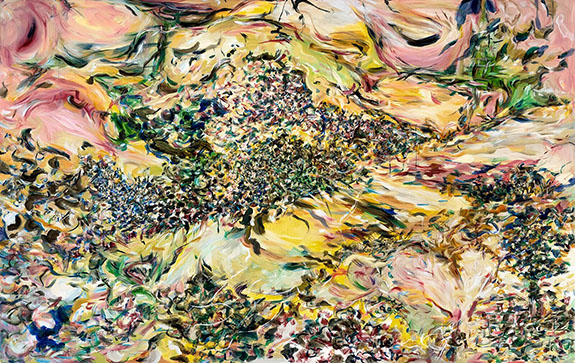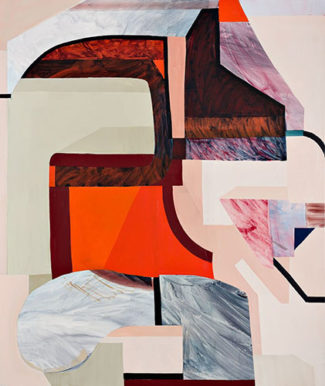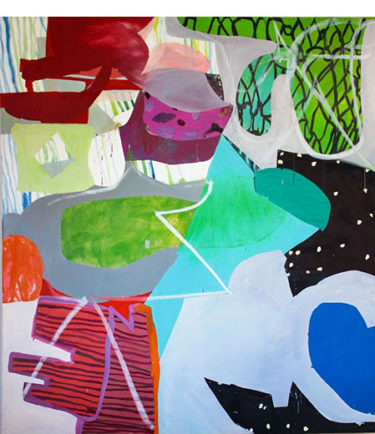
by Barbara Morris
Declarations of its demise notwithstanding, painting lives on, with the pulse of abstraction beating with particular vigor. While abstract painting has its roots in groups defined by movements or manifestos —Futurism (Italy), Blue Rider (Munich), Cubism (Paris), Abstract Expressionism (the New York School) and the Light and Space Movement (Southern California) — such clear distinctions no longer apply. Postmodernism created an open-ended context of actions and intentions, and as a consequence, the abstract impulse today flows free and unfettered, encompassing almost any work of art that departs from (or expands upon) real-world referents. How, then, to approach it?
About Abstraction offers one approach, and a compelling hook: all 16 artists involved are Bay Area women. This provocative curatorial stance poses the question: do gender-based shows help correct historical inequities or simply perpetuate them? Also, is there a Bay Area 
Many of the artists involved work conceptually, using the canvas as an arena for both action and guided processes, often with specific intentions and clear aesthetic goals. Nature-based abstraction is scarce, although several of the artists do incorporate specific features of their immediate environments into their palette, for example. Others are completely immersed in the act of applying paint.
Cornelia Schulz — distinguished by a 30-year teaching career at UC Davis and a long exhibition record – falls clearly into the latter group. She’s represented here by five tiny, irregularly shaped oil paintings, each of which packs an overwhelming punch. In L6, aggressive swaths of red and orange thrust from the upper edge of the work into a dense, thickly encrusted area consisting of a multitude of colors and shapes, all of them bunched together and whipped to a froth. L10, also with an angled shape just a bit off-kilter, uses overlapping layers of generously applied paint that direct the eye in more directions than might seem possible. The experience of looking at these obsessively worked canvases is akin to witnessing natural forces, like lava flows or churning waves, frozen in action.

Danielle Lawrence takes mixed media a step further with sculptural formations that spill off of or writhe across the surfaces of the paintings. Small-scale works, like Snake in the Grass, remind us that despite all the baggage borne by painters in the effort to stay relevant, painting can still be a playful, life-affirming pursuit. Heather Day also reveals, through mixed-media works like Junk Yard #6, a sense of exuberant experimentation. In this, a dynamic mash-up of dissimilar forms, executed in materials ranging from oil, enamel, and acrylic paint to pastels and spray paint, materialize the unconscious.
Naomi Kremer and Canon Tolon hew closest to what we might call “consensus reality.” Kremer's energetic and brushy works, such as A Vista, read as landscapes built around improbable perspectives with whirling, vertiginous qualities that recall Van Gogh's The Starry 
Donna Brookman's trio of massive and moody works on unstretched canvas call to mind action painting. fons et origo, executed on a black ground, features an outpouring of gestural marks and delicate lines that thrust, drip, shower and spark with a somber, meditative earth-rootedness that brings to mind Pat Steir’s Waterfall paintings.
Lorene Anderson’s swirling, pastel-hued works create the illusion of a landscape folding in on itself. You’ll find them flanking the trapezoidal section of the gallery dominated by Amy Ellingson's Variation: purple (dawn). Its fractured imagery flows seamlessly across four panels, creating a long, energetic field, like some scrambled 21st century cousin of Monet's water lilies. These disjunctions arise from a labor-intensive method that involves layers of computer-generated forms that are painted by hand and topped with a final layer of encaustic. The result is a palpable tension between hand- and machine-generated forms. The piece is flanked on either side by Op-ish paintings by Mel Prest that utilize diagonal meshes of parallel lines to create dizzying energy fields.

Alicia McCarthy, a mainstay of the Mission School, is represented by a large-scale work in which a overlapping bands of wiggling stripes recall weaving and textiles more than they do painting. In this the artist exhibits an unusual color sense: each successive color band responds to the adjacent hue, resulting in a muted rainbow of sorts, composed of ocher, umber, rust, and brick red on a gray ground. In the lobby, she’s installed a bigger, brighter version of this lattice in spray-paint, tucked under a curving staircase. The show also contains jewel-like, resin-and-acrylic works by Michele Théberge; glowing, mystical paintings in silicone, acrylic and ink by Michelle Mansour with raised dots evoking prayer beads; geometric, Kandinsky-meets-M.C. Escher gouaches by Romanian-born Emanuela Harris-Sintamarian; and intimate, highly formal acrylics by Eva Bovenzi.

In the end, curatorial decisions regarding which painters were ultimately selected and which were omitted might be second-guessed. So might the degree to which the show pushes the aesthetic envelope. Yet for most viewers, those concerns may be largely irrelevant, as the existing matrix has yielded a terrific show, one containing many of the strongest abstract painters in the Bay Area — regardless of gender.
# # #
“About Abstraction” @ Bedford Gallery through December 17, 2017.
Cover image: Detail: Amy Ellingson, Variation: purple (dawn), 2016, oil and encaustic on four panels, 50 x 156 x 2 inches
About the author:
Barbara Morris is a Bay Area-based writer and artist. She has been a regular contributor to Artillery and art ltd. magazines for the past seven years, and previously wrote for Artweek magazine for ten years, seven of them as a contributing editor. Her writing has appeared in WEAD magazine, stretcher.org, and Artist's Dialogue, as well as numerous other publications. Morris holds an MFA from UC Berkeley.
Thanks David! I will really enjoy this! Maridee in Napa
I printed it out to read later.